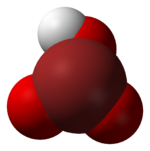ബ്രോമിക് ആസിഡ്

| |

| |
| Names | |
|---|---|
| IUPAC name
Bromic acid
| |
| Other names
Bromic(V) acid
Hydrogen bromate | |
| Identifiers | |
3D model (JSmol)
|
|
| ChEBI | |
| ChEMBL | |
| ChemSpider | |
| ECHA InfoCard | 100.029.235 |
| EC Number |
|
| Gmelin Reference | 25861 |
| MeSH | {{{value}}} |
PubChem CID
|
|
| UNII | |
CompTox Dashboard (EPA)
|
|
| InChI | |
| SMILES | |
| Properties | |
| HBrO3 | |
| Molar mass | 128.91 g/mol |
| Acidity (pKa) | −2 |
| Conjugate base | Bromate |
Except where otherwise noted, data are given for materials in their standard state (at 25 °C [77 °F], 100 kPa).
| |
HBrO3 എന്ന തന്മാത്രാസൂത്രത്തോടുകൂടിയ ഒരു ഓക്സോആസിഡ് ആണ് ബ്രോമിക് ആസിഡ്. ഇത് ഹൈഡ്രജൻ ബ്രോമേറ്റ് എന്നും അറിയപ്പെടുന്നു. ജലീയ ലായനിയിൽ മാത്രമേ ഇത് നിലനിൽക്കൂ. [1] [2] നിറമില്ലാത്ത ലായനിയാണിത്. ഇത് മുറിയിലെ താപനിലയിൽ ബ്രോമിൻ ആയി വിഘടിക്കുമ്പോൾ മഞ്ഞയായി മാറുന്നു. [3] ബ്രോമിക് ആസിഡും ബ്രോമേറ്റും ശക്തമായ ഓക്സിഡൈസിംഗി ഏജന്റ്സ് ആണ്. [4]
ഘടന
[തിരുത്തുക]HBrO3 ന്റെ നിരവധി ഐസോമറുകൾ ഉണ്ട്. [5] [6] G2MP2, CCSD(T), QCISD(T) എന്നീ സിദ്ധാന്തങ്ങളെ അടിസ്ഥാനമാക്കി കണക്കാക്കിയ ബോണ്ട് ദൈർഘ്യം ചുവടെ പട്ടികപ്പെടുത്തിയിരിക്കുന്നു.
| സ്പീഷീസ് | HOOOBr | HOOBrO | HOBrO2 | HBrO3 |
|---|---|---|---|---|
| Br–O bridged (Å) | 1.867 | 1.919 | 1.844 | - |
| Br–O terminal (Å) | - | 1.635 | 1.598 | 1.586 |
ഈ ഘടനകൾക്കിടയിലെ വലിയ ഊർജ്ജ തടസ്സങ്ങൾ ഐസോമെറൈസേഷൻ സാധ്യമാക്കുന്നില്ല. HOBrO2 ആണ് ഏറ്റവും സ്ഥിരതയുള്ള ഐസോമർ. [6]
സിന്തസിസ്
[തിരുത്തുക]ബേരിയം ബ്രോമേറ്റിന്റെയും സൾഫ്യൂറിക് ആസിഡിന്റെയും പ്രതിപ്രവർത്തനത്തിന്റെ ഫലമായി ബ്രോമിക് ആസിഡ് ഉണ്ടാവുന്നു. [1]
- Ba(BrO
3)
2 + H
2SO
4 → 2 HBrO
3 + BaSO
4
ബേരിയം സൾഫേറ്റ് വെള്ളത്തിൽ ലയിക്കാത്തതിനാൽ ഒരു അവക്ഷിപ്തം ഉണ്ടാക്കുന്നു. ബേരിയം സൾഫേറ്റ് നീക്കംചെയ്ത് ജലീയ ബ്രോമിക് ആസിഡ് വേർതിരിക്കാം
അവലംബം
[തിരുത്തുക]
- ↑ 1.0 1.1 The Merck Index: An Encyclopedia of Chemicals, Drugs, and Biologicals. 14th Edition. 2006.
- ↑ Van Nostrand's Scientific Encyclopedia. Glenn D. Considine. Ninth Edition. Volume 1. p 554
- ↑ Recipes for Belousov–Zhabotinsky reagents. J. Chem. Educ., 1991, 68 (4), 320. DOI: 10.1021/ed068p320
- ↑ The Source of the Carbon Monoxide in the Classical Belousov–Zhabotinsky Reaction. J. Phys. Chem. A., 2007, 111 (32), 7805–12 DOI: 10.1021/jp073512+
- ↑ Theoretical investigation of halogen-oxygen bonding and its implications in halogen chemistry and reactivity. Bioinorganic Chemistry and Applications, 2007, 1, 11/1–11/9
- ↑ 6.0 6.1 A Theoretical Examination of the Isomerization Pathways for HBrO3 Isomers. J. Phys. Chem. A, 2000, 104 (41), 9321-27. DOI: 10.1021/jp001604s
